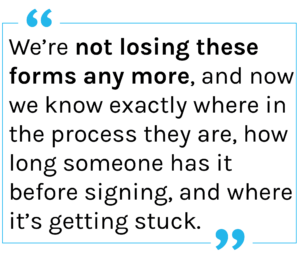Saving Time and Paper with the University of New England
Jessica Austin-Luce is the HR Information and Data Specialist at the University of New England in Maine. When she joined UNE in 2018 as a Recruiting Coordinator, the university had just gone live with PeopleAdmin’s Applicant Tracking System and Position Management solutions, upgrading from a highly manual, email-based application process. As ATS and Position Management started to make a big difference for recruitment, Jessica and her team started discussing the possibility of adding Employee Records before the pandemic hit.
In her recruiting role, Jessica spent a lot of time coordinating new hire paperwork. The hiring and onboarding process still involved sending out an email with a number of attachments that recipients were supposed to print before coming in on their first day—though the team kept packets at the front desk in case a new hire forgot to print something. Jessica frequently ran over to the business office to drop off paperwork, and spent time simply keeping track of physical documents. This process meant that Employee Records was an attractive option—but in 2020, the pandemic made it a necessity.
“For a while, there was one person in the office, one day a week,” said Jessica. “Almost no one has a printer anymore, and no one had a scanner, so there was no way for candidates to get documents to us. The implementation of Employee Records went smoothly, and we quickly started thinking outside of standard new hire paperwork. Six months in, we started collecting vaccination cards because the forms were so simple and easy to use. We sent that notification out to 1100 people, and everyone could take a photo of their card and submit it through their phones.”
This kind of onboarding is what new hires expect today, and UNE is glad to be away from manual processes. “People who come in through the new system see digitized onboarding as the standard today,” Jessica noted. “Hiring on paper just doesn’t happen any more.” The office has developed a robust new hire checklist that involves hard tasks that supervisors need to check off—for instance, making sure the employee has a computer on the first day. Jessica says that, thanks to the checklist, her office hears a lot fewer last minute requests for system access, because all these vital tasks have to be checked off before a new hire’s first day.
the new system see digitized onboarding as the standard today,” Jessica noted. “Hiring on paper just doesn’t happen any more.” The office has developed a robust new hire checklist that involves hard tasks that supervisors need to check off—for instance, making sure the employee has a computer on the first day. Jessica says that, thanks to the checklist, her office hears a lot fewer last minute requests for system access, because all these vital tasks have to be checked off before a new hire’s first day.
Jessica’s team, as well as other departments, keep coming up with new ideas for what to implement through employee records, including leave administration and an ID form for new employees through the security office. Recently, her office launched a flexible work policy sign-up through employee records. The simplicity of the policy and its launch caught the attention of the institutional giving office, and they are now looking into using Employee Records to set up annual giving through payroll. The recruiting office also conducted a new hire onboarding survey through Employee Records that went back three to six months, and they’ve been getting some interesting reporting and new metrics from the results.
In addition to the Employee Records implementation, Jessica has been working to expand UNE’s use of Position Management. One recent special project was digitizing personnel action forms.
“Personnel action forms were a big project. The previous process was that I would receive a form changing an employee’s position in some way—maybe their salary or their title—and I had to get that piece of paper physically signed by the division head, HR leader, provost, finance office, payroll, and myself,” says Jessica. “We moved to virtual signatures during COVID, but there were still a lot of hold-ups and data re-entry. All of that information is now in Position Management. We’re not losing these forms any more, and now we know exactly where in the  process they are, how long someone has it before signing, and where it’s getting stuck. Once everything is signed, it now automatically updates in Position Management. I realized that the process before could have been costing us money. If a personnel action form that was decreasing or increasing someone’s salary was sitting on someone’s desk waiting to be signed for a week, that’s a week when that budget hasn’t been changed and it should have been. With the process in Position Management, that won’t happen.”
process they are, how long someone has it before signing, and where it’s getting stuck. Once everything is signed, it now automatically updates in Position Management. I realized that the process before could have been costing us money. If a personnel action form that was decreasing or increasing someone’s salary was sitting on someone’s desk waiting to be signed for a week, that’s a week when that budget hasn’t been changed and it should have been. With the process in Position Management, that won’t happen.”
The University of New England is currently working on a Performance Management implementation, and the fast pace of the project inspired Jessica to share some advice.
“Make sure you understand your business processes and workflows before you start your implementation,” Jessica recommends. “PeopleAdmin’s implementations are brisk, so if you don’t have your processes locked down before, it can throw things off. You don’t have time to re-invent as you go.”